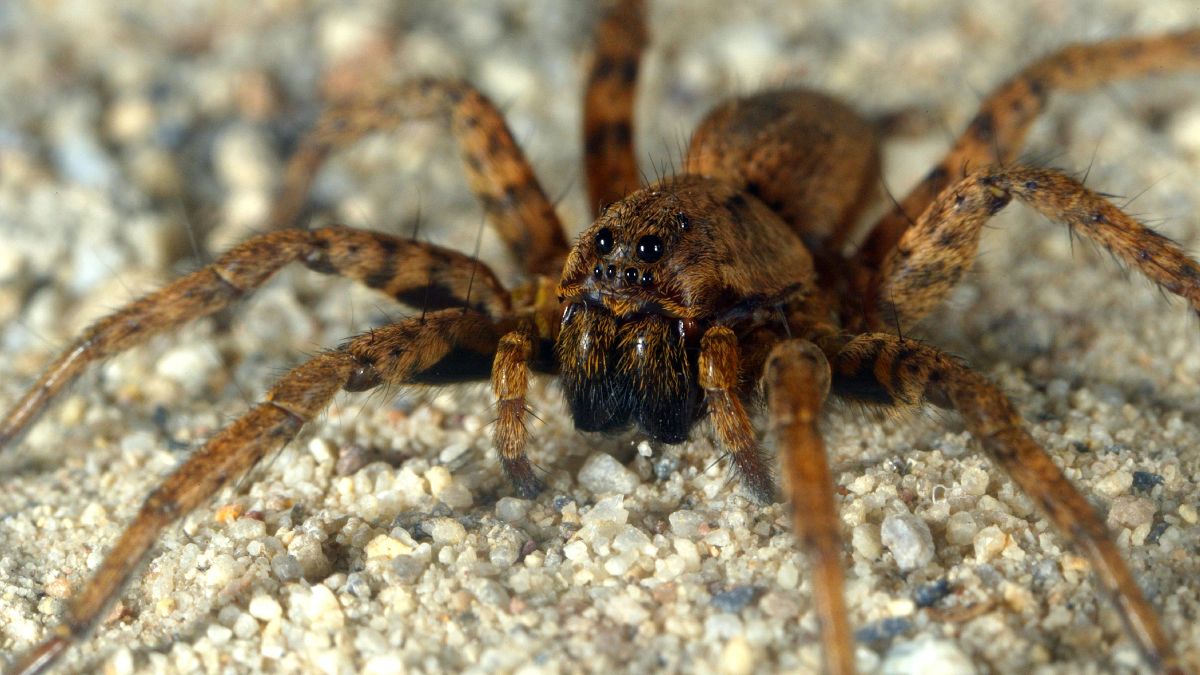When it comes to identifying Wolf Spiders and Brown Recluses, one of the key differences lies in their physical appearance. The Brown Recluse is known for the distinctive violin-shaped marking on its neck, a feature that sets it apart from the Wolf Spider. Additionally, if you look closely at their eyes, you’ll notice another variation – Wolf Spiders have eight eyes arranged in three rows, while Brown Recluses only have six.
In terms of legs, both spiders have eight legs like most arachnids. However, the proportions differ slightly between the two species. Wolf Spiders tend to have robust and hairy legs compared to the more slender legs of Brown Recluses. When it comes to coloration, Wolf Spiders typically display varying shades of brown or gray with striped patterns on their bodies; whereas Brown Recluses are generally light to medium brown with no distinct markings.
Table of Contents
Wolf Spider vs Brown Recluse: Location
The Wolf Spider vs Brown Recluse, one key difference lies in their preferred habitats. The brown recluse spider tends to favor dark, secluded spaces such as closets, basements, and attics. They are commonly found in areas with clutter or undisturbed piles of objects where they can hide and build their webs.
On the other hand, the wolf spider is more versatile in its location choices. These spiders can be found both indoors and outdoors, with a preference for grassy or wooded areas. Wolf spiders are known to roam freely on the ground hunting for prey rather than constructing intricate webs like other spider species.
Understanding the distinct locations where these two spiders thrive can help identify them if encountered. Whether it’s a quiet corner of your home for the reclusive brown recluse or a garden path for the wandering wolf spider, being aware of their typical habitats is essential when distinguishing between them.
Brown Recluse: The Violin on the Neck
The Brown Recluse spider, scientifically known as Loxosceles reclusa, is named for the violin-shaped marking on its neck. This distinctive feature sets it apart from other spiders and serves as a key identification factor. The violin pattern is often described as a dark brown mark with the base of the “violin” pointing towards the rear of the spider.
This marking can vary in intensity and shape depending on the individual spider, but it typically helps experts and individuals differentiate between a Brown Recluse and other species. While not all Brown Recluses may have a clearly defined violin shape, this characteristic remains an important visual cue when identifying these arachnids.
It’s essential to note that relying solely on this mark for identification purposes may not always be definitive, as other factors like behavior and habitat also play crucial roles in distinguishing a Brown Recluse from similar-looking spiders.
Wolf Spider vs Brown Recluse: Eyes
When it comes to distinguishing between the Wolf Spider vs Brown Recluse, one key difference lies in their eyes. The Brown Recluse typically has six eyes arranged in pairs, giving them a total of three sets. These eyes are usually quite small and can be difficult to see without magnification.
On the other hand, Wolf Spiders have eight eyes arranged in three rows. The bottom row consists of four small eyes, the middle row has two large forward-facing eyes, and the top row has two medium-sized eyes set back on the head.
The distinct eye arrangement of both spiders plays a crucial role in their hunting behavior and overall vision capabilities. While the Brown Recluse relies more on its web for prey capture due to poor vision, Wolf Spiders are known for their keen eyesight which aids them in actively hunting down their food.
Wolf Spider vs Brown Recluse: Legs
The legs of a Wolf Spider vs Brown Recluse, there are noticeable differences that can help distinguish between the two species. The Brown Recluse has long, thin legs that are usually uniform in color with no distinct markings or hair. These spiders typically have eight legs like most arachnids, which aid them in their movements and hunting activities.
On the other hand, Wolf Spiders have robust and hairy legs that enable them to move swiftly across various terrains. Their front pair of legs is typically larger than the rest and is often used for grasping prey while hunting. The hairs on their legs serve multiple functions, including sensory perception and trapping small insects as they navigate through their environment.
In terms of leg structure alone, observing these differences can be helpful in identifying whether you’re dealing with a Brown Recluse or a Wolf Spider when encountering them in your surroundings.
Wolf Spider vs Brown Recluse: Color
When it comes to color, the Wolf Spider vs Brown Recluse have distinct differences that can help you identify them. The Wolf Spider typically has a mottled gray or brown color with various markings on its body, allowing it to blend in well with its surroundings. In contrast, the Brown Recluse is usually a uniform brown color all over its body.
The coloring of these spiders serves different purposes in their respective habitats. The Wolf Spider’s coloring provides camouflage as it hunts for prey on the ground, while the Brown Recluse’s brown hue helps it hide in dark corners and crevices where it often resides. By understanding these color variations, you can better differentiate between these two spider species when encountering them in your home or outdoors.Remember that accurate identification is crucial when dealing with potentially dangerous spiders like the Brown Recluse, so pay attention to details such as coloration along with other distinguishing features to stay safe and informed.
Behavior of Wolf Spider and Brown Recluse
When it comes to behavior, the Wolf Spider and Brown Recluse exhibit distinct traits. The Wolf Spider is a solitary hunter, actively stalking its prey both day and night. These agile spiders do not spin webs but instead rely on their speed and agility to catch insects.
On the other hand, the Brown Recluse is a more reclusive spider, often hiding in dark and undisturbed areas like closets or attics. They are nocturnal creatures that prefer to avoid confrontation with humans. Unlike the Wolf Spider, they build small irregular webs where they wait for their prey to get entangled.
Both spiders can bite if threatened or provoked, but while the Wolf Spider’s bite may be painful due to its size, it is not considered medically significant. In contrast, the Brown Recluse’s venom can cause necrotic lesions in severe cases which require medical attention.Understanding these behavioral differences can help identify and handle encounters with these two arachnids effectively.
Appearance of Wolf Spider and Brown Recluse
When it comes to the appearance of wolf spiders and brown recluses, there are distinct characteristics that set them apart.
Wolf spiders are robust and hairy with prominent eyes that shine in light like tiny diamonds. Their bodies are typically dark brown or gray, often featuring stripes or patterns for camouflage. They have stocky legs enabling them to move swiftly on the ground.
On the other hand, brown recluses have a more slender physique with a characteristic violin-shaped marking on their cephalothorax. This marking is a key identifier when distinguishing them from other spider species. Their color ranges from tan to dark brown, and they lack obvious hair compared to wolf spiders.
In terms of size, wolf spiders tend to be larger than brown recluses, with some species reaching up to an inch in body length while most adult brown recluses measure about ¼ inch excluding leg span. Both these arachnids have unique appearances making them easily recognizable once you know what to look for.
Distribution of Wolf Spider and Brown Recluse
When it comes to the distribution of wolf spiders and brown recluse spiders, there are notable differences between the two species. Wolf spiders tend to be more widespread, found in various habitats across North America, Europe, Asia, and Africa. They thrive in grasslands, forests, deserts, and even urban areas.
On the other hand, brown recluse spiders have a more limited distribution. They are predominantly located in the central southern United States but can also be found sporadically in other regions like California or Florida. Brown recluses prefer dark and sheltered environments such as basements, closets, sheds, and woodpiles.While both spider species may inhabit homes or outdoor spaces depending on their habitat preferences…
Venom of Wolf Spider and Brown Recluse
The venom of a wolf spider and a brown recluse differs significantly in potency and effects. Wolf spiders are not known for having venom that poses a serious threat to humans, as their bites typically result in mild symptoms like redness or swelling. In contrast, the venom of a brown recluse contains potent cytotoxins that can cause tissue damage, resulting in necrotic wounds.
When comparing the venoms of these two spiders, it’s crucial to understand that while wolf spider bites may be uncomfortable, they are generally harmless. On the other hand, brown recluse bites can lead to severe reactions requiring medical attention.
Although both spiders produce venom for subduing prey, the impact on humans varies greatly. It’s essential to familiarize yourself with these differences to know how to react if you encounter either species. Understanding their venoms can help you take appropriate measures if bitten by one of these arachnids.
Habitat of Wolf Spider and Brown Recluse
The habitat of the wolf spider and brown recluse differs significantly, impacting where you might find these arachnids. Wolf spiders prefer outdoor environments like gardens, fields, and woodlands. They are commonly found in grassy or leaf litter areas since they don’t build webs to catch prey but actively hunt for insects instead.
On the other hand, brown recluse spiders tend to seek out dark and secluded indoor spaces such as basements, closets, attics, and even shoes or clothing left undisturbed for long periods. These recluses favor dry environments with little human activity where they can spin their irregular webs close to the ground.
Understanding the preferred habitats of these spiders is crucial in identifying potential encounters with them. While wolf spiders may startle you outdoors during gardening activities, brown recluses might be lurking in quiet corners inside your home without you even realizing it until spotted unexpectedly.
Conclusion: Wolf Spider vs Brown Recluse
Wolf Spider vs Brown Recluse- These two are fascinating creatures that play important roles in their ecosystems. Understanding the key differences between these two spiders is crucial for identifying them correctly and taking appropriate actions if encountered.
While both species can be found in similar regions, they have distinct characteristics that set them apart. The brown recluse’s violin-shaped marking on its neck, unique eye arrangement, lighter coloration, and reclusive behavior distinguish it from the wolf spider. On the other hand, the wolf spider’s robust build, darker coloring with stripes or markings, hunting habits, and prominent eyes make it easily recognizable.
When it comes to habitat preferences and venom potency, there are significant variations between the two species. Wolf spiders prefer outdoor environments like grasslands and forests where they actively hunt for prey without posing a significant threat to humans. In contrast, brown recluse spiders seek dark hiding spots indoors and outdoors but should be handled with caution due to their potentially harmful venom.
By familiarizing yourself with these distinctions between wolf spiders and brown recluses, you can better protect yourself from potential encounters and appreciate these arachnids’ unique traits in nature. Remember always to exercise caution when dealing with any spider species to ensure your safety while coexisting peacefully with these remarkable creatures in their natural habitats.









